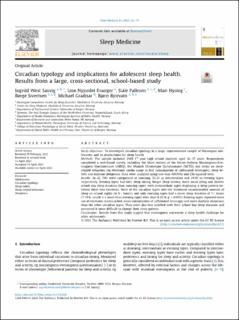| dc.description.abstract | Study objectives
To investigate circadian typology in a large, representative sample of Norwegian adolescents, and its implications for sleep health.
Methods
The sample included 3920 1st year high school students aged 16–17 years. Respondents completed a web-based survey, including the short version of the Horne-Ostberg Morningness-Eveningness Questionnaire (rMEQ), the Munich Chronotype Questionnaire (MCTQ) and items on sleep-related behaviors (eg electronic media usage in bed, consumption of caffeinated beverages), sleep beliefs and daytime sleepiness. Data were analyzed using one-way ANOVAs and Chi-squared tests.
Results
In all, 7.8% were categorized as morning, 52.3% as intermediate and 39.9% as evening types, respectively. Evening types had later sleep timing, longer sleep latency, more social jetlag and shorter school day sleep duration than morning types, with intermediate types displaying a sleep pattern between these two extremes. None of the circadian types met the minimum recommended amount of sleep on school nights (ie 8+ hours), and only morning types had a mean sleep duration of 7+ hours (7:19 h, nearly 1 h more than evening types who slept 6:20 h, p < 0.001). Evening types reported more use of electronic media in bed, more consumption of caffeinated beverages and more daytime sleepiness than the other circadian types. They were also less satisfied with their school day sleep duration and perceived it more difficult to change their sleep pattern.
Conclusions
Results from this study suggest that eveningness represents a sleep health challenge for older adolescents. | en_US |

